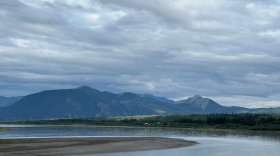As the 2024 Yukon River salmon season kicks off, there will once again be little to no opportunity for communities along the Western Alaska river to harvest any actual salmon.
One small exception is summer chum. If the run hits half a million fish, residents of the lower reaches of the Yukon may have the chance to take to the river with dipnets and other non-traditional gear for a brief window like they did in 2023.
But as Holly Carroll, the Yukon River subsistence fishery manager for the United States Fish and Wildlife Service noted in April, these types of opportunities may not be worth the effort for many along the river.
“Who's going to spend nine bucks a gallon to go out fishing with a dipnet?” Carroll asked. “It might take them four or five hours to get seven chums. Whereas if they had been given their six-inch gillnet, they put it out for a minute, minute and a half, and they're done. They'll have 100. Then they'll spend the next couple of days cutting and smoking, and they're done for the season.”
While communities cannot count on these types of heavily restricted opportunities to meet their subsistence needs in 2024, one thing they can count on is a total closure of chinook salmon fishing for the next seven years. Carroll said that the recently signed Alaska-Canada agreement was overdue.
“For me as the federal manager, I see this as the bold step that needed to be taken. We're just not seeing the returns off those runs that we would have liked. I really felt that it was time,” Carroll said. “I also think we really needed to listen to our tribal stakeholders who have been telling us for years that this annual approach is not a great way to manage.”
The seven-year agreement calls for rebuilding chinook stocks to the point that at least 71,000 of the fish cross into Canada each year. It is technically not a moratorium, as meeting this number at any point in the next seven years would in theory lift the closure. But in 2024, fewer than 15,000 fish are expected to complete the journey.
Many believe that trawler bycatch plays an outsized role in keeping chinook and chum from returning to the Yukon River. But Carroll said that the fish are up against a lot in terms of a changing environment.
“I think they're dealing with a lot more climate changes, certainly warming oceans, different food sources, the food is moving to different areas,” Carroll said. “We've seen less healthy fish. Their gas tanks are less full when they go to make that migration. We're seeing heat stress, we're seeing warm temperatures when they come into the river.”
Since 2019, Carroll said that chinook numbers recorded on the upper Yukon River at Eagle have fallen drastically below corresponding numbers far downriver at Pilot Station. Biologists believe one thing that may be killing them off somewhere along that nearly 1,100-mile journey is the disease-causing Ichthyophonus parasite.
According to a 2022 report by federal and state biologists to the Alaska Board of Fish, the severity of Ichthyophonus infections has been found to peak somewhere near the midway point of the river in Alaska. But going further upriver, severely infected fish were rarely found, the report said.
Carroll said that scientists are also researching chinook salmon eggs to try and identify potential threats to future stocks. They want to know whether low levels of the vitamin thiamine that have been linked to early salmon mortality are further impacting the fish.
In 2024, the clock is ticking as scientists try to understand what is happening to Yukon River salmon. But as Carroll acknowledged, the clock is also ticking when it comes to communities along the river simply being able to feed themselves.
“How can we get people more food? And if it is with selective gear, how do we get people using them? Because they're not traditional, they're not easy, they're not efficient,” Carroll said. “We all need to get to the table and figure out how to get people some food while still protecting the chinook while we rebuild them.”
The first chinook of the season are likely entering the lower Yukon River at this moment. With luck, they’ll make it to their natal streams, protected by the efforts of communities with whom they are inextricably connected.









